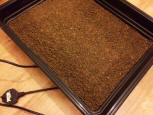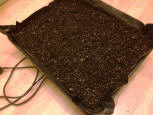Episode 1 Ė early January
Christmas is over and our Grandchildren have enjoyed their big countdown
to Santa Claus when they excitedly kept us up to date with how many
sleeps they had left until the big day. Well, itís my turn now and Iíve
only got a few sleeps left until my big day when I start up the first of
my tubers!
The
first batch will be in before the 10th January. They are some
soon to be retired adult tubers to provide me with early cutting
material that will hopefully be available by the end of February. Over
the last couple of years, I have had great fun experimenting with
producing blooms on a cutting. Ian Donaldson has championed this method
that quite a few growers are now following and although I was more than
happy with the results that I got from them last year, I suspect Ė and
hope, that we all have a lot more to learn.
It
reminds me of my chrysanthemum growing days in some ways as exhibition
chrysanthemums are flowered on cuttings taken from the previous years
plants. I somehow donít think we will ever get to the point where
begonias are grown exactly this way, because the smaller tubers produced
by flowering cuttings donít seem to be capable of producing a sufficient
amount of cutting material, but who knows what the future holds. I can
however see the time when adult tubers are retired a lot younger in
order to provide cutting material and we will all be growing our plants
on younger tubers and cuttings. This should result in improved form and
we will also be using smaller pots and less compost as a result.
In
addition to the varieties that have proved successful for me so far,
which are:
∑
Colin Hamilton
∑
Symestar
∑
Alexandria
∑
Daisy Trinder
∑
Tigger
I
will be adding:
Golden Hind Ė far better on a cutting tuber than anything older
because blooms on older tubers usually loose form completely in the last
week of development. Itís a strong vigorous grower so well worth a try.
Iíll just have to be extra vigilant during the flowering period because
in a 2 litre pot Ė which I am using for all my flowering cuttings,
drying out will be a real issue and you simply cannot afford to let that
happen to one of the worst Ďedgersí around∑
Nichola Coates Ė I tried this in 2016 with encouraging
results, whereas in 2017 my blooms were very big but rather coarse when
grown on two and especially three year old tubers.
Ann Crawford Ė I tried one plant in 2016 and it was promising
enough for an extended trial Ė no lack of size and it looked a bit
rounder with less of a letterbox centre.
Gipsy Ė one of my double center varieties that only seems to do well
on a cutting tuber for me, so time to try it on a cutting.
There
are some other varieties that I think will respond to this method; Iíll
see what cutting material is available in March and Iíll try a few of
them for Dundee.
I use
my Wards / Stewarts electric propagators to produce my early cutting
material. Mine donít have adjustable thermostats and tend to run quite
hot so I put three centimeters of damp sand in the bottom (below left)
then cover this with a layer of polythene sheeting (below centre) before
adding the compost (below right). The compost is 5 parts Levington M2 to
1 part Vermiculite. Filling the compost right to the top of the
propagator also helps to keep the temperature down at root level.



I
donít see any point in giving these old tubers plenty of space as they
should have produced the cuttings that I need before they become too
root bound and run out of compost, so I just pack them together as close
as I can because they will only be required for cutting production. I
can always give them a half strength balanced feed if they look like
they need it. This early in the season, I leave the propagators in the
conservatory (an understanding wife is a big help here, but Iíll really
be pushing my luck over the next 3 months as I use it more and more as
my overspill propagation greenhouse rather than heat one of the other
ones!) and I donít put the lids on as this also increases the
temperature too much. Propagator thermometers are essential to monitor
the temperature.

One
of my challenges this year will be to have blooms from cuttings
available for the National. For my first attempt at flowering cuttings
in 2016, I rooted in early April for the Fife show in the middle of
September. Based on those promising results, in 2017 I rooted them on 10th
March for Dundee on 1st September. At the time I secured the
buds, the plants were well developed (see below) and in some cases I
could even have secured the previous buds, so Iím hoping that by trying
to root a couple of weeks earlier I will get a few blooms out in time
for Shrewsbury.

Whatís keeping me awake at night?
Ė I
donít know about other members but thereís often something begonia
related that stops me from nodding off at night, so Iíll try to share
one each month!
Right
now itís tuber storage Ė up until now, I have been very happy about my
tuber survival rate. We have never put the car in the garage, so there
was always plenty of room to store the tubers and crucially, it was well
insulated and dry. I have never recorded a November to February
temperature in the garage lower than 3įC and that was with an outside
temperature of -7įC.
That
all changed in April 2017 when we converted most of the garage into a
hobby room for my wife Pauline. The Ďgarageí is now a 12í x 5í storage
space accessed by the old garage door that has an area big enough to
overwinter the boxes of adult tubers but on the colder nights we have
had so far it hasnít been as warm as it used to be because now they are
nearer to the door, there is less heat exchange from the house and the
smaller space does not seem to retain as much heat from during the day Ė
Iíll just have to ensure that I keep checking, especially on the nights
that the temperature is forecast to drop. A maximum minimum thermometer
is essential throughout the storage period. I also have covers on
standby but only for the cold nights, as I prefer to have plenty of air
circulating during the storage period.
My
real venture into the unknown is cutting tuber storage. Like many
growers, I leave mine in their pots until January because there is a
risk of dehydration if they are removed from the compost too early.
Previously this wasnít an issue as there was plenty of room in the old
garage but so far I have been shuffling them between the greenhouse and
our conservatory, depending on the outside temperature. Although I am
keeping them frost free, I am concerned with the effect of them being in
constant light and fluctuating temperatures compared to the constant
dark and the steadier temperature of the garage. Iím not sure what the
impact will be, itís just my old system seems more akin to what a
Ďperiod of dormancyí should be like. Itís one to watch for now and Iíll
try to come up with a better system for next winter. One option is to
use my propagating benches with the thermostat set at around 5įC but as
the tubers will still be in their 1 litre pots, I wonít be able to
accommodate them all, so I am also thinking about slightly reducing the
pot size for 2018.
On
the subject of tubers, so far at least, I am very happy with the absence
of vine weevil grubs on my adult tubers. Last season was the first time
that I have used parasitic nematodes, Steinernema Kraussei to control
them and so far itís been a success. I know that I had them last year Ė
I even caught my first ever adult beetle, (see below) but the only
evidence of grubs I have found so far are a very small number of their
tell tale entry marks, but they only penetrate a couple of millimeters
and the tubers have healed so I guess that is the point that the
nematodes got to them! I just need the same results on my cutting tubers
for it to be a complete success. I have an unopened 1 litre bottle of
the old type Provado that I will keep as an emergency back up, but from
now on it will be the nematodes for me.

Footnote Ė Iím also a very keen photographer who should have known
better and taken the Ďbeforeí version of the vine weevil beetle, but the
begonia grower won and dispatched it without thinking, meaning the
Ďafterí version is all that I have!
Next
episode Ė starting up the cutting tubers